Feedback on Road Diet Largely Positive at Public Information Session

Audio By Carbonatix
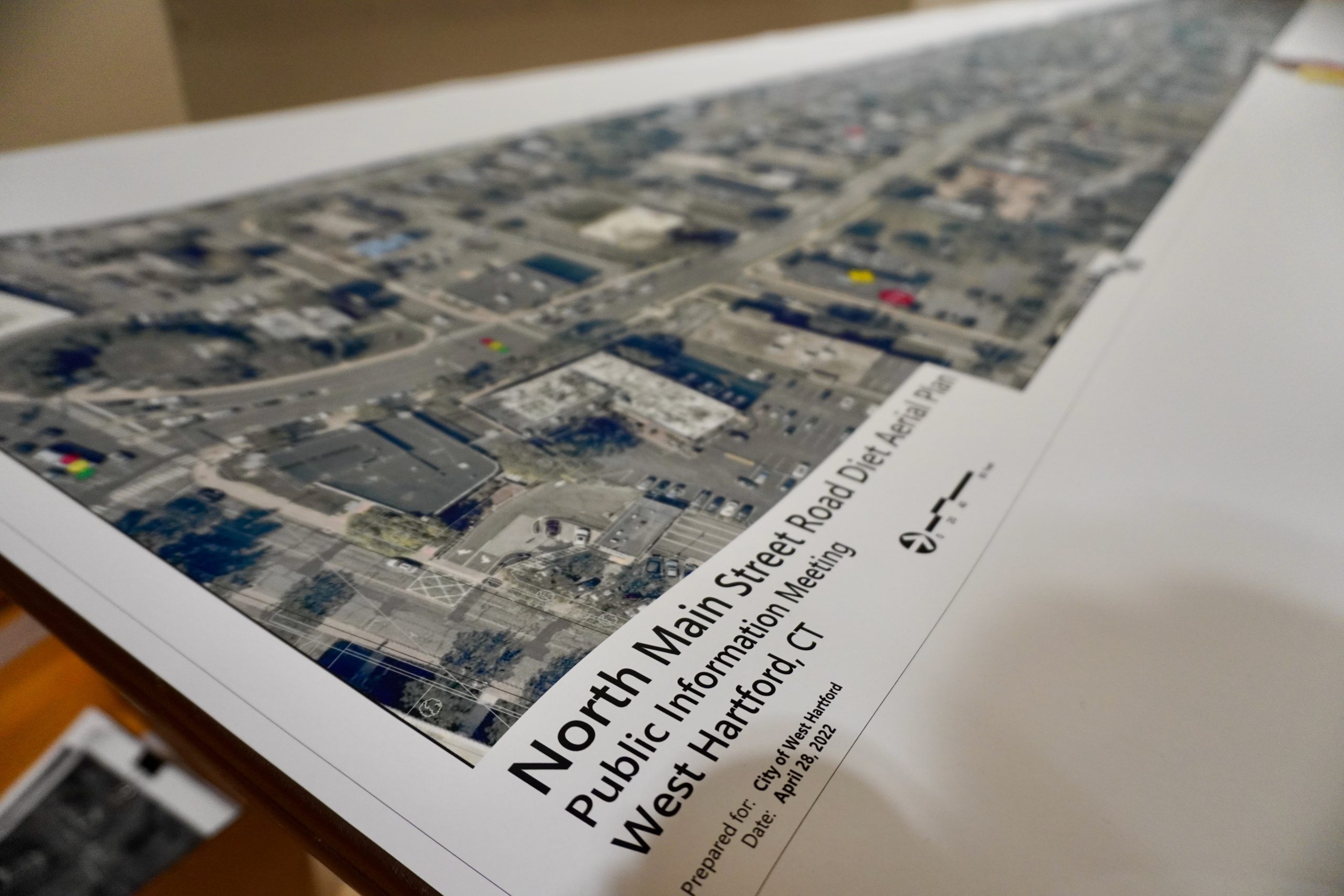
The North Main Street road diet information session had a display of the complete stretch of impacted roadway. Photo credit: Ronni Newton
The Town of West Hartford and the project design consultant held a public information meeting on April 28 to discuss the results of the North Main Street Road Diet Trial.
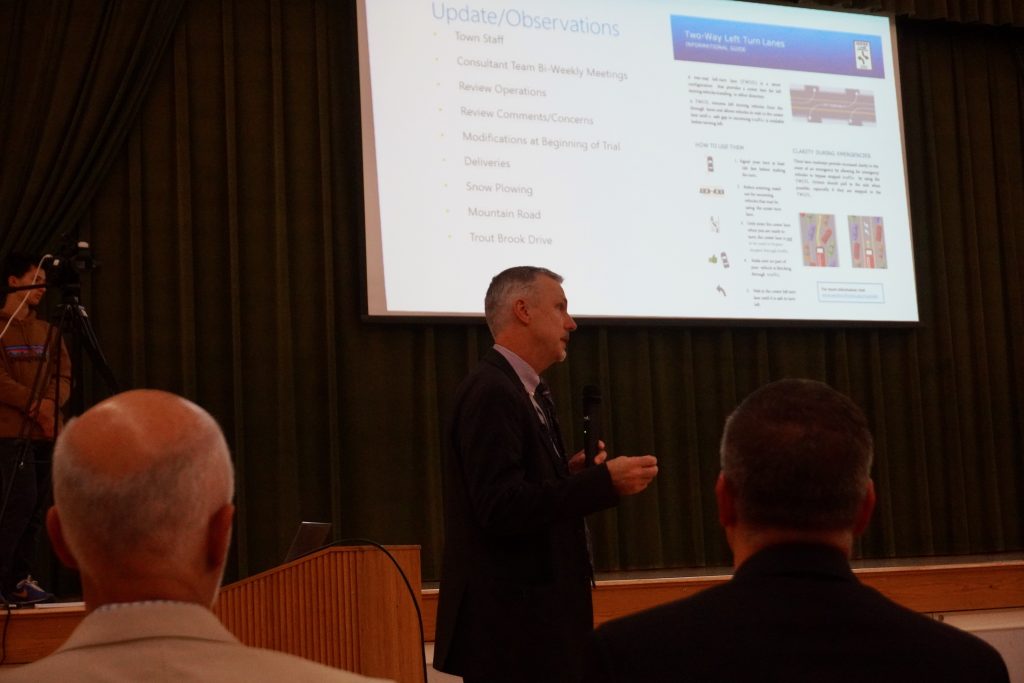
Joe Balskus of VHB, the town’s consultant for the North Main Street Road Diet trial, presents data at a public information session at West Hartford Town Hall. Photo credit: Ronni Newton
By Ronni Newton
Project consultant Vanasse Hangen Brustlin, Inc. (VHB) presented results of the North Main Street Road Diet trial at an information session at West Hartford Town Hall last week, inviting additional public input in advance of a presentation to the Town Council scheduled for May 24.
A recommendation regarding the future of the road diet will be made at that time, Joe Balskus, VHB’s director of Transportation Systems, said.
Roughly 75 people attended the session Thursday evening, and more than a dozen took the opportunity to express their opinions about the transformation of a section of North Main Street – between West Hartford Center and Bishops Corner – from two travel lanes in each direction to one travel lane with a 12-foot-wide “two-way-left-turn-lane” (known in the transportation industry as a “TWLTL”). Shoulders, of various widths, have also been marked on the roadway during the trial.
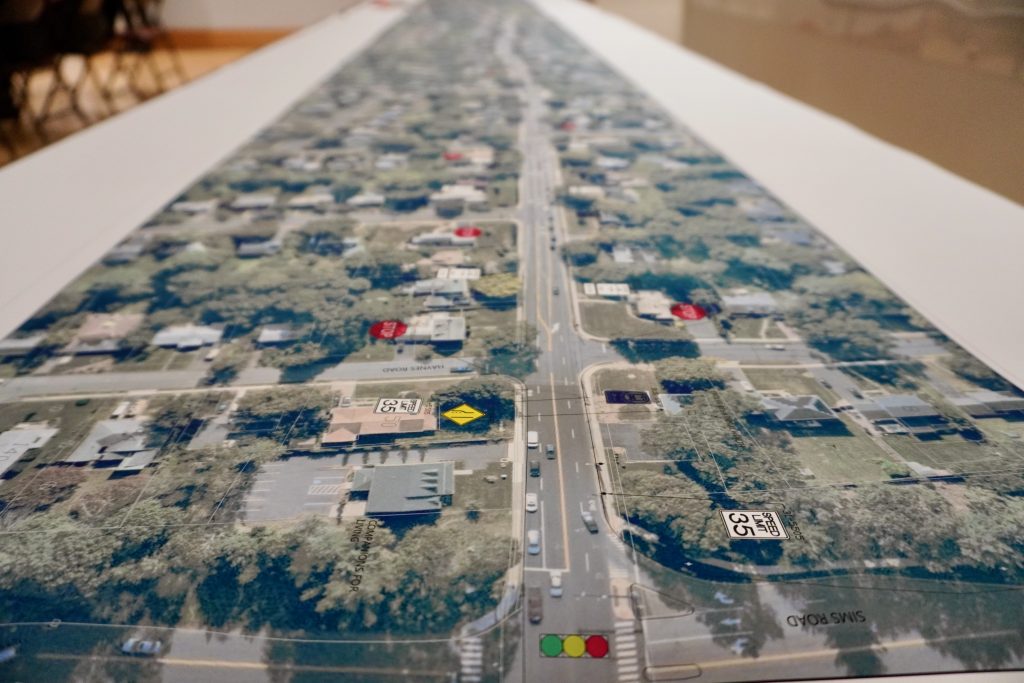
The North Main Street road diet information session had a display of the complete stretch of impacted roadway. Photo credit: Ronni Newton
Balskus said he has been meeting with town staff regularly, typically ever two weeks, since the road diet trial began in August 2021, and also noted that the overall study included not just North Main Street but also the impact on Mountain Road, Trout Brook Drive, and the side streets in the area.
A comparison of crash frequency and severity, pedestrian and bicycle usage and safety, traffic counts compared to pre-pandemic volume, traffic speed, queuing at lights and intersections, and accessibility to driveways and side streets were among the performance criteria analyzed in the study.
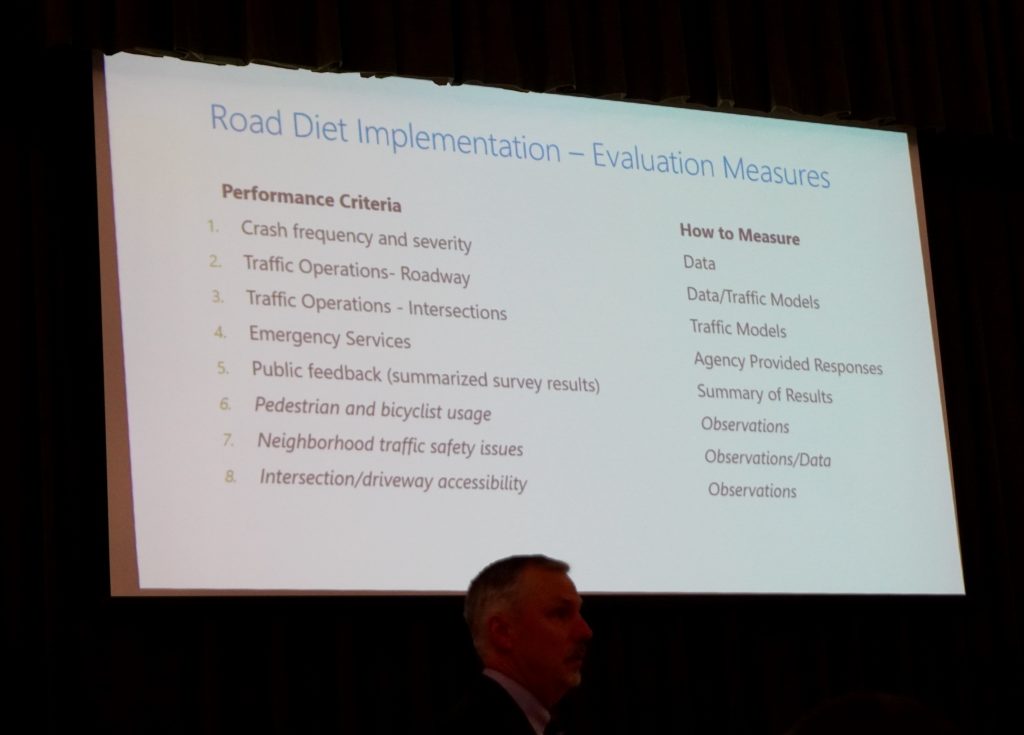
Joe Balskus at VHB discusses performance criteria analyzed for the North Main Street Road Diet trial at a public information session at West Hartford Town Hall. Photo credit: Ronni Newton
Balskus said data was collected from the police and other emergency services, from traffic cameras installed at key intersections, from a drone flight, from field observations that he and VHB staff conducted that included looking at use of the TWLTL and the ability of buses to navigate turns, and from public feedback provided through surveys, emails, and calls.
Balskus said he even rode his bike along the stretch of impacted roadway on April 24 to get a better feel for how safe the corridor felt while on a bike, and how the traffic reacted to a bicyclist riding in the shoulder.
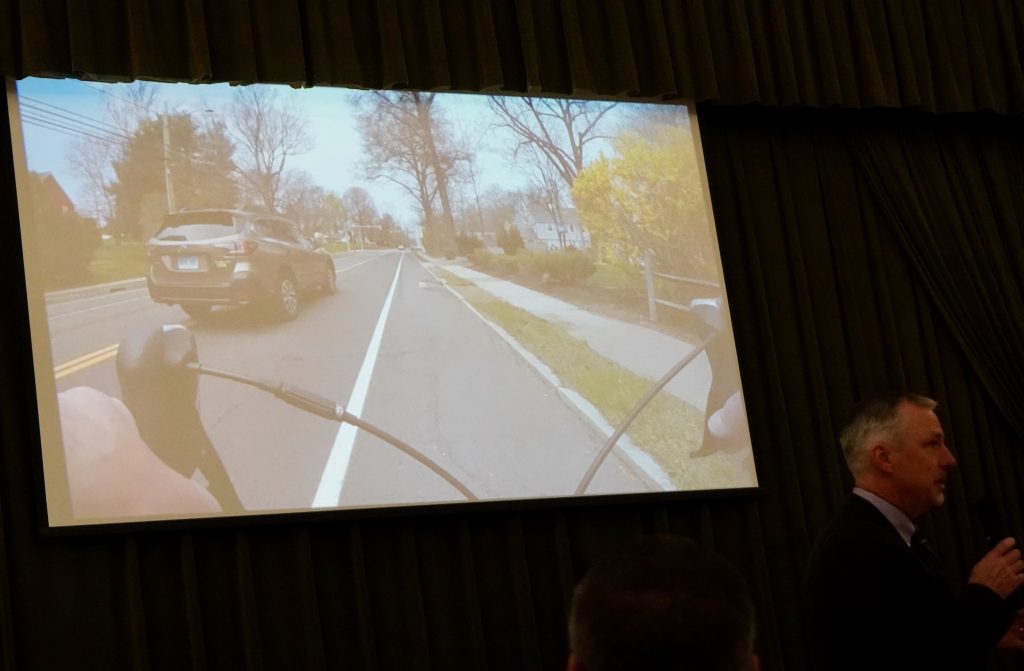
View from consultant Joe Balskus’ bike ride along North Main Street. (screenshot)
The results presented by Balskus Thursday, and the resulting effect, indicated:
- Crash frequency and severity has been reduced along North Main Street, which is a positive result.
- Travel times along the roadway are increased due to reduced speed, which is manageable. Queues have been mitigated at the intersections of Fern and Asylum, Balskus said, through changing in the timing of the signals.
- Traffic backup at intersections has increased, but to a level that is manageable. The diversion of traffic from North Main Street to other roadways has been minimal, and signal timing can further manage queuing.
- Emergency services reported no life safe concerns, and agencies are supportive of the road diet, Balskus said.
- Regarding public feedback, Balskus said, there have been more than 200 comments logged. “We’ve see a majority supportive of the road diet trial,” he said.
“The bottom line is, our No. 1 criteria, crash data, has shown to be reduced,” Balskus said at the public information session. A summary of the crash data analysis can be found on the project website.
Balskus said that prior to the trial there were concerns about cut through traffic from motorists avoiding North Main. “We think that has abated,” he said.
The goal of increasing the feeling of safety for pedestrians and bicyclists appears to have been met, he said. Balskus said that when he rode his bike along North Main Street the paved shoulders as they exist are wide enough along most of the route and are smooth. He said he didn’t feel like the traffic was going by him unsafely or at excess speed.
When the drone flight was conducted, in December 2021, it showed a significant traffic back-up that blocked the access to the driveway at the American School for the Deaf. Balskus said that issue has been mitigated by changing the timing of the signal at Fern Street.
Regarding accessibility to driveways and intersections, Balskus said drivers do see a difference in gaps in traffic due to “platooning” of vehicles, which can make turning onto North Main more difficult. However, he said, there are fewer lanes to cross with the road diet.
Most residents who attended the public information session praised the road diet as a vast improvement which makes North Main Street feel so much safer, but many also shared some lingering concerns as well as issues that have arisen because of the new pattern.
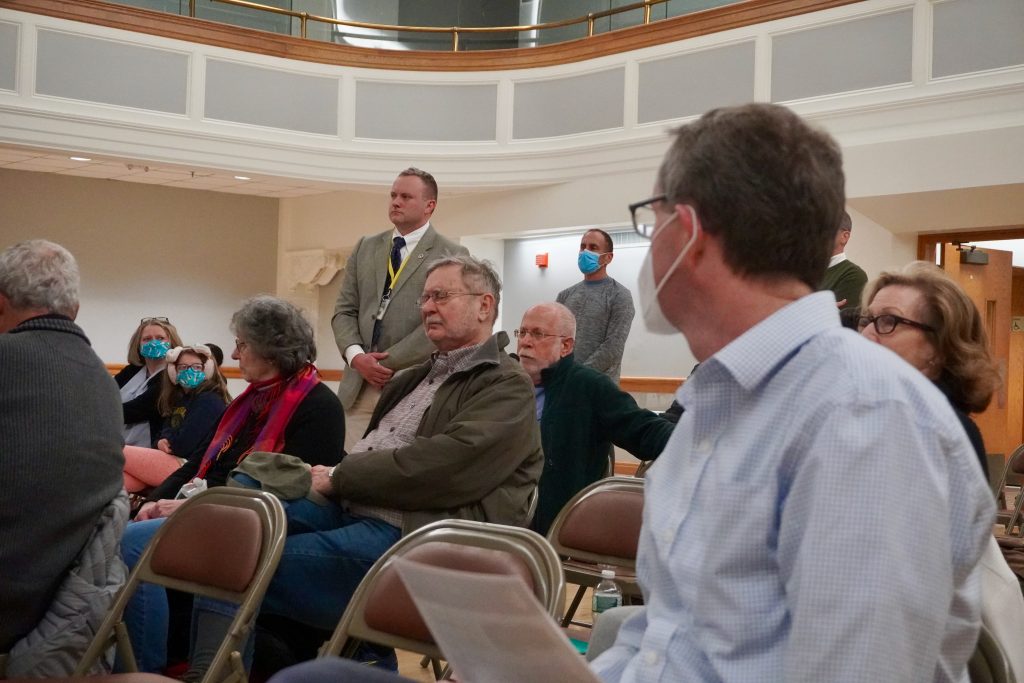
Residents attending the public information session about the North Main Street Road Diet trial had the opportunity to ask questions following a presentation. Photo credit: Ronni Newton
A Hilltop Drive resident said she had stopped trying to turn left out of her street to go north on North Main and instead uses Fern, which is also “a nightmare.” She told Balskus that it’s not just a problem at peak times but rather at most times of the day, and suggested a left-turn arrow for drivers to turn north from Fern onto North Main. Balskus said that’s a change which is under consideration. He also said that since the pandemic, “peak hours” have changed and are no longer concentrated at traditional “rush hour” times.
A Wyndwood Road resident said that during the North Main Street bridge construction residents of her street had the luxury of a traffic signal, but since the light was removed it’s difficult for drivers to turn left onto North Main, and much harder for pedestrians to cross. “Would you consider a blinking light that people could access to cross the road?” she asked. Balskus said some type of signal is being explored.
Others who commented also suggested some type of crossing signal for pedestrians, noting that people walk to the American School for the Deaf and families who live in the “horseshoe neighborhood” also need to cross to walk to and from Bugbee Elementary School.
“I no longer feel like I’m going to die when I’m walking or mowing my lawn,” said North Main Street resident Matt Warshauer. He said that while it may take longer to get out of his driveway, “that tiny bit of time is so worth it.”
Warshauer also suggested a signal would be very helpful for those who need to cross North Main Street to get to and from Bugbee.
North Main Street resident Isaac Kamola, who lives across from the American School for the Deaf, said it “feels just a lot safer to get out of my driveway.” He said he’s originally from the west coast, and when he first relocated he thought people drove like maniacs on North Main, but the road diet has had a calming effect. “It’s a huge improvement in quality of life,” he said.
One North Main Street resident said while the road diet is a “huge success,” he would not consider using it for biking, even though he is an experienced cyclist. “There is work to do,” he said.
“I pretty much avoid travel from the hours of 3 p.m. and 7 p.m.,” said a Fern Street resident who said cars are either exceeding the speed limit or the traffic is crawling. “Yes there are positives, but at what cost?” he said, noting the possible environmental issues created from cars backed up at intersections.
Scott Franklin, a local attorney and a prior chair of the town’s Pedestrian and Bicycle Commission which has long supported the concept of a road diet, said a former client told him a few years ago that the idea of a road diet on North Main was “the dumbest thing ever.” He recently heard from that former client, who apologized.
“It’s a great testament that our town has bought into this,” Franklin said. “It’s real change, and it’s a change definitely for the positive.”
Acting Town Manager Rick Ledwith said the next step in the road diet trial will be incorporating the comments from Thursday night’s public information session, followed by presentation of a report with recommendations to the Town Council.
Options may include keeping the road diet as is, maintaining a road diet but implementing additional changes which may include altering other impacted intersections, or returning to the former roadway configuration.
VHB’s recommendations will be presented to the Town Council on May 24, and the final decision about the road diet will be made by the town manager who serves as the town’s Legal Traffic Authority.
Additional information about the road diet trial is available on the project webpage.
Like what you see here? Click here to subscribe to We-Ha’s newsletter so you’ll always be in the know about what’s happening in West Hartford! Click the blue button below to become a supporter of We-Ha.com and our efforts to continue producing quality journalism.



